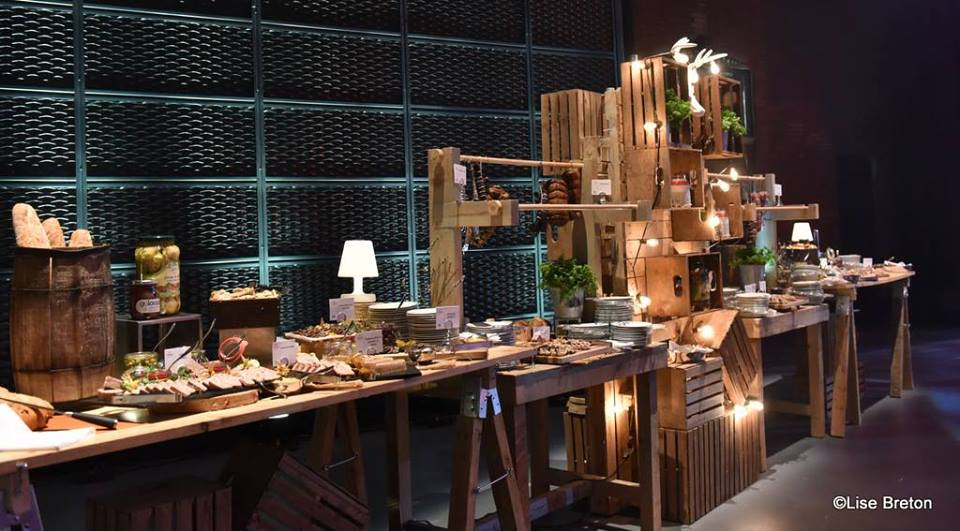28 June 2019
Minimizing the Environmental Footprint of Your Next Event

Events have environmental, social, and economic impacts. As an event promoter, manager, or planner, you’re in a position to use green event management to reduce your environmental footprint. And your attendees will notice everything—from small gestures to ambitious initiatives.
Recycling today is a well-established practice, and composting is getting there. Another trend is to eat less meat and rely more on vegetarian and vegan alternatives. The idea of local and collective sourcing and consumption is gaining ground, and people are increasingly concerned about the environment and animal welfare. Statistics on environmentally friendly practices show that Quebecers are eager to adopt new behaviours—across the board—for the benefit of the community.
Green event management shows that you as a manager care about the environment. Better still, it makes a real difference.
Learn about environmental responsibility
Environmental responsibility plays a pivotal role in the environmental footprint of an event. The idea is to reduce negative impacts and increase positive ones, with a view to sustainability. The goal isn’t necessarily perfection, it’s to bring in more and more practices that reduce your environmental footprint. And attendees appreciate the effort. In a survey by the Ethical Consumption Monitor:*
- 39.9 % of respondents had heard of “green events”
- 15.3 % of respondents could spontaneously name at least one event they perceived as green
Given society’s growing awareness of how our actions impact the environment, these numbers will likely rise significantly over time.
*(Observatoire de la consommation responsable)
Identify challenges and set environmental goals
Making a green event work depends on the efforts and cooperation of everyone involved, at every level. This includes both staff and attendees.
The main challenges in green event management are awareness, education, and changing habits. Take a moment before you start planning and work out some clear, specific, measurable goals. Remember that even small steps matter, as long as they’re in the right direction.
Of course, even the best-thought-out goals don’t (generally) meet themselves, so you’ll likely have to set aside part of your budget for green initiatives. But don’t spend so much that the other aspects of the event suffer. Often all it takes is a slightly different approach, and sometimes the green solution actually saves you money. We’ll share a few such solutions further on.
Know and target green consumer profiles
Knowing your target audience is essential in planning any kind of event. In green event management, you need to take your audience’s sense of environmental responsibility into account. The Ethical Consumption Monitor has developed six green consumer profiles with the support of Recyc-Québec, based on what consumers expect of businesses in terms of social and environmental responsibility and the degree to which their own actions reflect ethical and environmental concerns. Attendee profiles provide a key indicator of which green initiatives are likely to be effective.
The Deep Greens
This group accounts for 14 % of the population and scores the highest for ethical consumption. Deep Greens are noted for being early adopters of green consumption practices such as buying in bulk, avoiding processed sugar, and others. Many vegetarians, vegans, and devotees of the Mediterranean diet fall into this category. They generally expect a great deal from businesses. Respect for stakeholders, environmental awareness, and social responsibility are important to them.
Profile:
- Mainly male (59.8 %)
- Age 25 to 44 (49.6 %)
- Married or in common-law unions (18.9 %)
- Bachelor’s, master’s, or doctoral degree (36.4 %)
The Crusading Greens
They make up 26 % of the population and score high for overall green consumption, except in sustainable transportation. Many are vegetarian or vegan or follow the Mediterranean diet. Crusading Greens are more demanding of businesses than Deep Greens. Over 90 % demand ethical treatment of stakeholders, environmental awareness, and social responsibility on the part of businesses.
Profile:
- Mainly female (55.4 %)
- Age 45 to 64 (38.8 %) or 65 and over (34.6 %)
- Divorced (16.2 %)
- Two children (25.8 %)
- Bachelor’s, master’s, or doctoral degree (31.9 %)
- Homeowner (60 %)
Green-Oriented Locals
This category accounts for 16 % of the population. They’re conscious of the fact that something needs to be done and they make efforts as far as they’re able. Green-Oriented Locals generally know they need to do better. They also expect a lot from businesses in terms of environmental action and treatment of stakeholders.
Profile:
- Mainly female (55.9 %)
- Married (38.5 %) or in common-law unions (26.1 %)
- Two children (31.1 %)
- Bachelor’s, master’s, or doctoral degree (36.6 %)
- Homeowner (63.4 %)
Human-Oriented Locals
For 23 % of the population, buying local is what matters. Human‑Oriented Locals have ethical consumption practices when it comes to recycling. Their expectations for businesses are very high in terms of stakeholder treatment, the environment, and social responsibility. Overall, their expectations are a lot higher than their behaviour would indicate.
Profile:
- As likely to be male as female
- Equal distribution across age categories
- More likely to be single (32.8 %) or married (31.9 %)
- No children (52.2 %)
- Homeowners (55.6 %)
- High school diploma or equivalent (44.8 %)
Recyclers
Recyclers make up 12 % of the population. Their ethical consumption is limited to recycling. Lactose-free diets are also relatively common. Their daily efforts are minimal and they expect little from businesses, except in the area of stakeholder treatment.
Profile:
- Mainly female (59.2 %)
- No children (66.3 %)
Not-So-Ethical Consumers
They make up 9 % of the population. Many are young adults. They don’t appear to reject the possibility of adopting ethical consumer behaviours in the future but currently have other priorities. Most use sustainable transportation, recycle, purchase locally, and favour ethical production. They show a certain openness. Price is an important consideration for this group. Their expectations of businesses are relatively low, but they still expect more from businesses than from themselves. They’re aware of the importance of stakeholder treatment, the environment, and social responsibility.
Profile:
- Mainly age 18 to 24 (18.1 %) or 25 to 44 (43.6 %)
- Single (54.8 %)
- No children (66.3 %)
- No certificate, diploma, or degree (18.1 %) or high school diploma or equivalent (37.2 %)
- Renters (75.5 %)
- Annual income is $ 40,000 or less
Understand the environmental impact categories
There’s no shortage of material available for businesses managing green events, and there are plenty of guides and standards available. Two of the main ones in Quebec are MDDEP’s guide, entitled Guide sur l’organisation d’événements écoresponsables (Guide to Green Event Organizing), and Bureau de normalisation du Québec’s BNQ 9700-253 standard, entitled Sustainable Development: Responsible Event Management. Both use a six-category model for reducing impacts at the source.
Purchasing
Choose energy-efficient equipment. Establish a preferential-purchasing policy that favours local, fair-trade, and reusable materials and support Quebec farmers. Voltigeurs de Québec Armoury’s two caterers— George V banquet and catering services of Hôtel Château Laurier Québec and the Caterer of Château Frontenac—can help you create a local-fare menu for your event.

Food and tableware
Current dietary trends are heading towards a more moderate consumption of meat and a preference for local produce and fair-trade imported foods like coffee. Talk to your caterer about providing vegetarian and other options in line with those trends. Don’t hesitate to provide your attendees with information on product origins—some items may be a revelation for them. Seasonal menus are also popular and available from Voltigeurs de Québec Armoury’s caterers. Tableware should always be reusable. Single-use articles like plastic knives, forks, and straws are to be avoided wherever possible. Choose serviettes and tablecloths made of linen or other fabric.

Waste
Choose products with little or no packaging to reduce the amount of waste generated. Consider having waste-sorting stations to separate garbage from recycling and compost. You may be surprised at how well attendees pitch in. You can add an explanatory panel for guidance and to raise awareness or even have a waste-sorting director.
Greenhouse gases
Hold your event in facilities that can be easily reached using public transit. Take a moment to talk to your attendees about their options for getting around. Clearly indicate the bus routes to the hall as well as where they can park. The Armoury is, incidentally, steps from many bus routes, making it easy for anyone to get here from anywhere. Try too, if possible, to organize staff and supplier travel to minimize emissions.
Communications
One way to make your event greener without spending a lot of money is to cut down on printing. Simple ways to reduce paper consumption include posting materials online and emailing invitations. You can also use signs or screens to display information onsite. If you absolutely have to print something, use recycled paper and double-sided printing. There are many printer shops that offer deals on two-sided printing.

Additional resources
We’ve looked at only two of the many green-event management guides and standards available. Two other standards are ISO 1400 for environmental management and ISO 50001 for energy management.
The International Organization for Standardization website has lots more about both of them. In general, the ISO 1400 family of standards recommends practices and tools for companies looking to live up to their responsibility to fight climate change, while ISO 50001 supports energy efficiency, which also ends up saving you money.
Awareness above all
Tell the attendees about the green initiatives your team has put in place. It helps encourage them to get on board. As an example, you can ask conference-goers to bring their own coffee mugs or hand out free ones. It’s an opportunity to raise awareness and perhaps even spark a change in their habits and behaviours.
The Ethical Consumption Monitor has an environmental awareness index you can use to evaluate your success in raising awareness. It is described as a tool for measuring people’s understanding of the different elements that make up a green event by looking at seven steps in the event lifecycle:
- Selecting suppliers
- Managing materials
- Managing energy and water sources
- Managing waste
- Selecting and managing food
- Selecting means of transportation
- Informing and raising awareness
Approaching these seven steps from a green perspective will lay the foundation for a successful green event.
Be flexible
Always be aware of the response you’re getting, both in the planning stages and during the event itself. Be open to attendee and staff comments. Use them to find out what works and what doesn’t so you can do better next time out. Sustainability is a never-ending process. But bear in mind that every action, no matter how small, makes a difference.
And remember—caring for the environment is one differentiation strategy that attendees really do value.